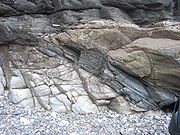
Stoping
Encyclopedia

Magma
Magma is a mixture of molten rock, volatiles and solids that is found beneath the surface of the Earth, and is expected to exist on other terrestrial planets. Besides molten rock, magma may also contain suspended crystals and dissolved gas and sometimes also gas bubbles. Magma often collects in...
tic bodies from their sources in the mantle
Mantle (geology)
The mantle is a part of a terrestrial planet or other rocky body large enough to have differentiation by density. The interior of the Earth, similar to the other terrestrial planets, is chemically divided into layers. The mantle is a highly viscous layer between the crust and the outer core....
or lower crust
Crust (geology)
In geology, the crust is the outermost solid shell of a rocky planet or natural satellite, which is chemically distinct from the underlying mantle...
to the surface. The theory was independently developed by Canadian geologist Reginald Aldworth Daly
Reginald Aldworth Daly
-External links:* Daly′s Biography, American Geophysical Union* GSA Today, vol. 16, no. 2, 2006* National Academy of Sciences, Washington, DC, 36 pp., 1960...
and American geologist Joseph Barrell
Joseph Barrell
Joseph Barrell was an American geologist who proposed that sedimentary rocks were produced by the action of rivers, winds, and ice , as well as by marine sedimentation. He also independently arrived at the theory of stoping as a mechanism for igneous intrusion...
.
The process involves the mechanical disintegration of the surrounding country/host rock, typically through fracturing due to pressure increases associated with thermal expansion of the host rock in proximity of the interface with the melt. Once fractures are formed, melt and/or volatiles will typically invade, widening the fracture and promoting the foundering of host rock blocks (i.e. stoped blocks). Once suspended in the melt, stoped blocks may either sink or float depending upon the density of the block relative to that of the melt. Additionally, blocks submerged within melt are subject to further thermally-induced fracturing which may account for the often observed "lack of evidence" for the process of stoping.

